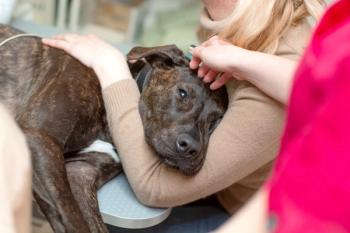
- dvm360 May 2022
- Volume 53
- Issue 5
- Pages: 44
What’s new in the clinical practice of dentistry? The oral microbiome

Research is empowering clinicians with predictive tools for preventive dentistry
Content submitted by Basepaws, a dvm360® Strategic Alliance Partner
It is generally agreed that dental diseases including tooth resorption, periodontal disease, and the signs of halitosis affect many of the adult cats we see daily in practice. It has also been shown that if left untreated, dental diseases can spread to other organ systems including the heart and kidneys.1
Dentistry can be challenging, involving diagnostics, performing treatment and postoperative evaluation, and assessing prevention compliance. Looking forward, examining the oral microbiome in states of oral health and disease may hold the key to unlock the ability to predict halitosis, periodontal diseases, and tooth resorption as well evaluate posttreatment return to health and the positive effect of prevention protocols.
Daily plaque composed mostly of gram-positive bacteria and oral debris attach to the teeth and gingiva. In time, if not disturbed through chemicals or mechanical means, a bacterial biofilm colonizes over the teeth, tongue, cheeks, gingival sulcus, tonsils, and hard and soft palates. The community of microbial residents that reside in the oral cavity is called the microbiome. After the gut, it is the second largest microbial community.2 The genome is the complete set of DNA in our patient’s bodies.
The oral microbiome is an exciting and expanding field of research. Oral microbiome differs in states of health and disease. Differences in the make-up of the oral microbiome may be the cause of oral diseases or show up at the same time but not be causative. Identifying the microbiome in health is the first step of microbiome research, after which it is necessary to understand the role of the microbiome in the alteration of functional and metabolic pathways associated with the diseased states.
Basepaws Dental Health Testing has gathered oral samples from thousands of cats and will soon be exploring dogs to study the link between the oral microbiome and halitosis, periodontal diseases, and tooth resorption.
How might Dental Health Testing be adopted in our offices?
- Since the current exam room assessment of oral health is primarily visual, the microbiome may prove predictive for present or future tooth resorption, halitosis, or periodontal disease.
- The exam room test is noninvasive, with a simple collection method.
- The main potential benefits include early detection and/or predictive risk, evaluation of disease prevention recommendations and intervention, and ongoing management of dental diseases.
- It can potentially increase client compliance with higher acceptance of our recommendations.
- It provides education to the pet parent about hidden oral disease signs and symptoms.
- There are potential long-term health care cost savings from early detection, treatment, and control of disease.
- It offers potential peace of mind for the client that, at the time of the test, their pet’s mouth was healthy.
- Pet parents can take a more-involved active role with at-home care (ie, changes in normal daily behaviors) to keep the semi-annual microbiome testing normal.
I feel the potential to improve prediction and early detection of underlying dental diseases would be a win for practicing veterinarians, patients, and pet parents. With earlier intervention and preventive measures, our pets can receive better-quality care that can be more cost-effective for the client in the long run. While research in this field is ongoing, the findings so far have been promising. I look forward to seeing what is on the horizon and will keep you posted as the oral microbiome research develops.
Further reading
- Davis EM. Gene Sequence Analyses of the Healthy Oral Microbiome in Humans and Companion Animals. J Vet Dent. 2016;33(2):97-107. doi:10.1177/0898756416657239
- Thomas S, Lappin DF, Nile CJ, et al. Microbiome analysis of feline odontoclastic resorptive lesion (FORL) and feline oral health. J Med Microbiol. 2021;70(4):001353. doi:10.1099/jmm.0.001353
- Rodrigues MX, Bicalho RC, Fiani N, Lima SF, Peralta S. The subgingival microbial community of feline periodontitis and gingivostomatitis: characterization and comparison between diseased and healthy cats. Sci Rep. 2019;9(1):12340. Published 2019 Aug 26. doi:10.1038/s41598-019-48852-4
References
- Verstraete FJ, Kass PH, Terpak CH. Diagnostic value of full-mouth radiography in cats. Am J Vet Res. 1998;59(6):692-695.
- Caselli E, Fabbri C, D'Accolti M, et al. Defining the oral microbiome by whole-genome sequencing and resistome analysis: the complexity of the healthy picture. BMC Microbiol. 2020;20(1):120. Published 2020 May 18. doi:10.1186/s12866-020-01801-y
Articles in this issue
over 3 years ago
The impact of Fear Freeover 3 years ago
The secret to happy clientsover 3 years ago
An encouraging phone call and a flopping horseover 3 years ago
Euthanasia attendants in modern practiceover 3 years ago
Lyme disease risk forecast to increaseover 3 years ago
Maximizing adherence to minimize heartworm resistanceover 3 years ago
A closer look at hydrotherapy for rehabilitationover 3 years ago
Why a blood smear evaluation should be performed with every CBCNewsletter
From exam room tips to practice management insights, get trusted veterinary news delivered straight to your inbox—subscribe to dvm360.




